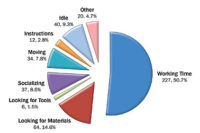For parents, one of the most challenging occurrences in raising kids is dealing with the many phases they go through. Having only raised boys, I can’t say if it’s harder to go through these phases with daughters, but I can say that boy phases are difficult enough.
Once the kids are grown, they begin the adult phases just like you and I did. As adults we go through the college, work and marriage phases and then kids arrive and we get to go through all their phases. It’s an interesting circle of life similar to the phases we experience on construction projects.
In construction, we go through the “get work” and “do work” phases. In the beginning, everyone works together harmoniously. As work progresses, we go through other phases moving us from the honeymoon phase to married. It’s during the married phase that we experience the ups and downs, and phasing can be one of them.
Not Just a Phase
The tell tail signs of a deteriorating schedule is when we see large portions of work broken down into much smaller work areas. For example, the original schedule indicated that you would have an entire floor of 10,000 square feet to perform your work, however, for a variety of reasons the contractor decides to break the entire floor into five different two thousand square foot areas. In other words, you have no additional work, you just have to do the same amount of work in five phases rather than one phase.
The question is whether or not it will cost you more, less or the same amount of money to complete your work in five phases rather than one phase? To answer this question I want to suggest that you answer it by asking yourself the following:
Schedule
- Will each of the five phases begin and end without a change to the original start and completion dates for the entire floor?
Sequence
- Will the sequence of your work change as a result of having five phases rather than one?
Manpower
- Will manpower flow from one phase to the next properly?
- Will five phases cause ramp up or ramp down of manpower?
Supervision
- Will additional supervision be required in managing five verses one phase?
Material-Equipment
- Will material or equipment costs increase as a result of having five phases rather than one?
Phasing Example 1
Contractor finds that they have to leave out a concrete pour strip at 24 of the 48 locations on each floor as a result of a design change. The contractor decides to phase in the areas where they cannot pour concrete, meaning you will be able to work in 24 of the areas, on each floor, but not all 48 areas on each floor as originally planned.
As a result, you have to decide if there’s an additional cost to complete the 24 phases on each floor that at some point will be phased in? We would then ask the same questions:
Schedule
- Will each of the 24 phases on each floor begin and end without a change to the original start and completion dates for the entire project?
Sequence
- Will the sequence of your work change as a result of having 24 phases on each floor rather than one?
Manpower
- Will manpower flow from one phase to the next properly?
- Will 24 phases on each floor cause ramp up or ramp down of manpower?
Supervision
- Will additional supervision be required in managing 24 phases per floor verses one phase?
Material-Equipment
- Will material or equipment costs increase as a result of having 24 phases per floor rather than one phase?
Didn’t See That Coming
Some subcontractors might call this sort of work “go-back work”,but the fact remains that when an area is not ready for you as originally scheduled and you pass it up, it becomes a phase rather than a go-back. Are subcontractors deceiving themselves by not pricing phasing costs?
Yes, they are deceiving themselves because if the phasing was not part of the original schedule, the estimator who bid the job could not have included the cost to phase the work.
For an example, if an estimator bid a job that had 10 phases per floor rather than one phase, the estimator would have bid the job differently to include the cost of 10 phases rather than one. In other words, if the schedule shows only one phase per floor the cost would be lower than a schedule showing 10 phases per floor. If you as a project manager were told that each floor will have 10 phases rather than one phase, the first thing you would ask is, “Where is the money for the 10 phases?”
Not to pick on project managers, but they are quick to point out to their estimators what was missed. In fact, if an estimator happened to miss that each floor was broken down into ten phases rather than one, the project manager is very likely to point out that the estimator missed the phasing costs.
Although, many project managers are quick to point out this error to their estimator, they have a difficult time pointing it out to the general contractor who decided to phase the work. As you know, we often hear after the job completion that the job went bad because it was poorly scheduled, phased and sequenced. You would think owners and executives of subcontracting companies would be tired of hearing this excuse.
No Flow Joe
Most contracts include a schedule indicating start-completion dates, sequencing and phasing (if any). Again, if an estimator knows going in that the schedule is very complicated as a result of short duration completion dates, multiple phases and having to perform work out of the sequence, the price will reflect a higher cost.
However, when an otherwise simple schedule goes awry with deviations in start-completion dates, sequencing and phasing, most project managers don’t bat an eye until they realize how much money will be lost on the job. So let me ask again, why don’t project managers get tough on phasing of work?
When they are told that phasing isn’t actually adding work, most project managers don’t know what to say. The truth is, phasing can and often times does increase costs in the form of lost productivity, higher equipment costs, deviations in manpower and overall continuity in workflow.
Unplanned phasing interrupting flow or continuity is like pulling a snowball uphill rather than pushing it downhill to make it bigger. It will take a lot more effort to pull it rather than push it. In other words, unplanned phasing is inefficient unless you get paid for it.
If there are no phases shown in your budget, the job cost won’t include phasing. In other words, if the budget for a job didn’t include phasing and the costs associated with phasing, one would have to conclude that the bid schedule didn’t include any phasing.
However, when the work actually starts and phasing becomes an issue and therefore a cost, a price should be submitted for phasing and then incorporated into the budget as a budget update.
Phasing Isn’t Free
Having to phase your work is rarely free. Phasing is often times the result of unforeseen problems the general contractor feels can be overcome by phasing. Understanding why GCs decide to phase work not originally planned to be phased, is key in presenting your additional phasing costs. How you present your phasing costs isn’t that difficult, it’s really a matter of convincing yourself before you have to convince your client.
Again, the easy way to determine if phasing is going to cost you more money is to ask yourself or someone else how phasing will impact, schedule, sequence, manpower, supervision, material and equipment costs.
At some point you will look at your clients attempt to get phasing past you for free as laughable because you’ve learned the difference between phasing that costs you money and phasing that doesn’t. If you would like to learn more about the SSMS program please go to subcontractorconsultant.com.






Report Abusive Comment